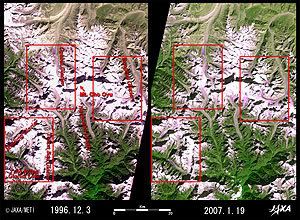Bleak picture indeed:Nowhere is climate disruption more dramatically apparent than on the roof of the world – where some experts predict Himalayan glaciers may be gone in as few as 40 years.
The snows of the Himalayas feed the headwaters of the Yellow, Yangtze, Ganges and Mekong Rivers and provide drinking water for billions throughout Asia.
* * *
The Himalayas are the water towers of Asia. We all live in the same building and we have this big water tank on top of our house and when that water runs out we're all gonna suffer. It's not just gonna be the people who live near the mountains. Now when we're talking about one, well, one and a half billion people – it doesn't look very good. I mean, even now, if you look at the region, there's a lot of tensions between the nations, you know, especially between Pakistan and India. Now when people don't have access to fresh water, they may see access to fresh water on the other side of the border, so we're looking at maybe mass migration, you know, heightened conflict. And it's just a very, very bleak picture.

Western Mt. Everest.
Look close and note how much more green you see now where once there was snow packed glaciers. A more detailed examination of the melt as viewed from space can be seen in this photo essay. But even more dramatic is this short video from the ground, comparing panoramic pictures taken in 1921 and comparing them to what greets the intrepid climber today.
When I was my daughter's age, we were all supposed to "Give a Hoot, Don't Pollute." Clean air and drinking water, a pristine environment were a moral imperative to pass on a hospitable planet to our children. Now it's a matter of survival.
 Exposing the lack of compassion by conservatives and
debunking right wing hypocrisy at every opportunity.
Exposing the lack of compassion by conservatives and
debunking right wing hypocrisy at every opportunity.





 Subscribe via Email
Subscribe via Email
0 Comments:
POST A COMMENT